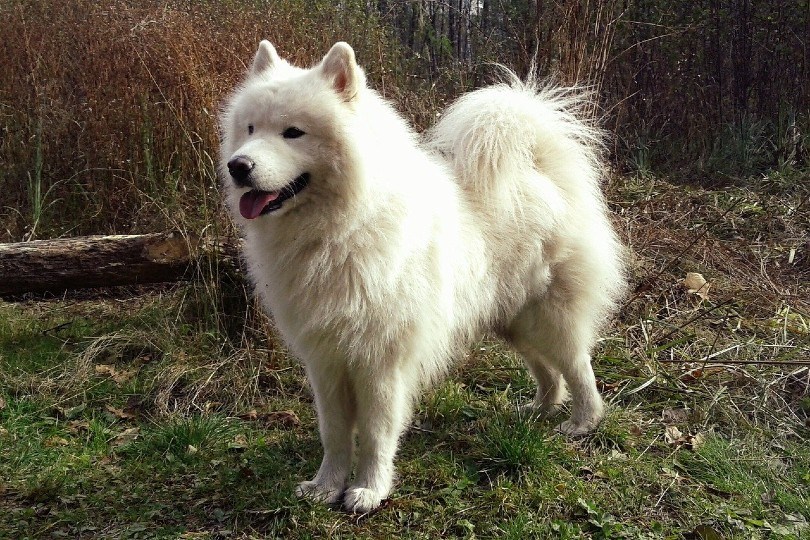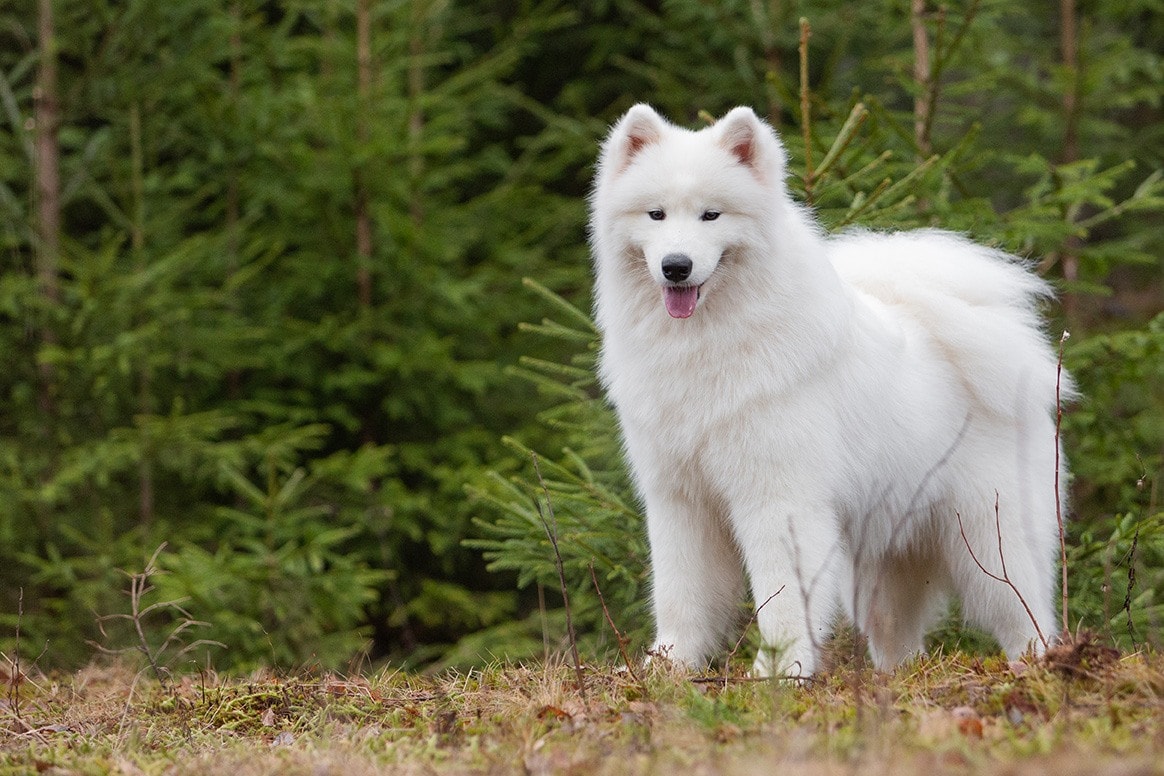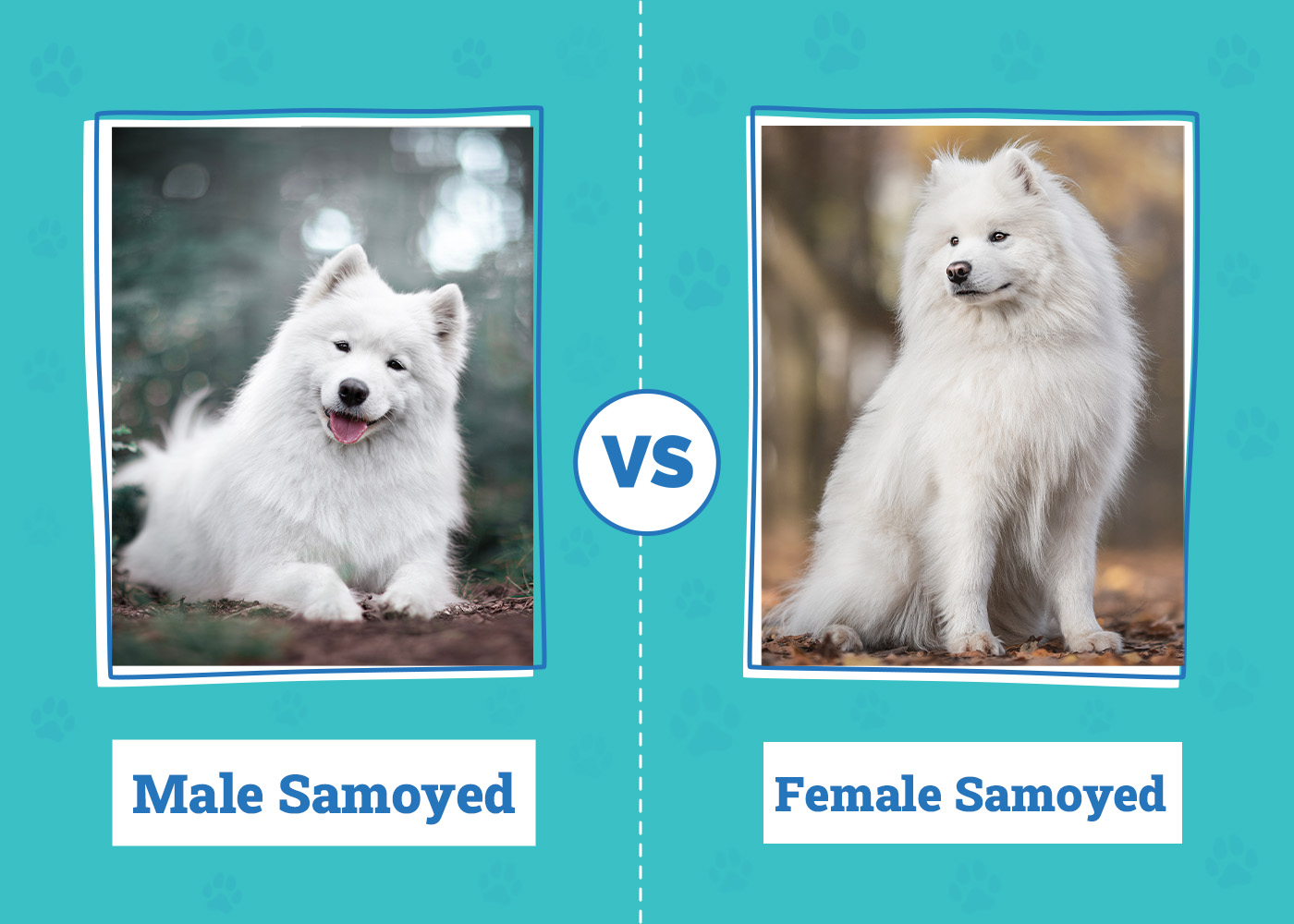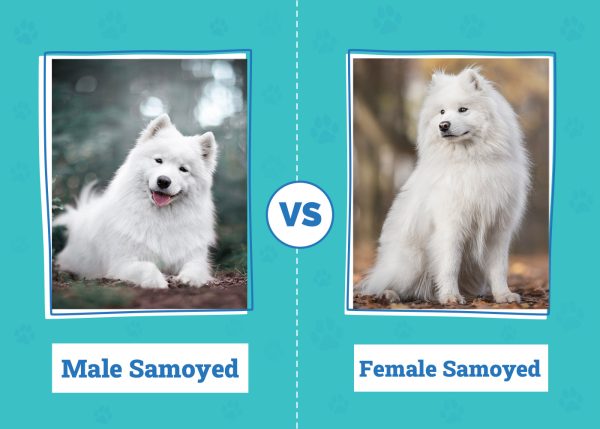When looking for a new dog, one of the first topics that seems to come up is the main differences between a male and a female dog. Medium and large dog breeds tend to have the more noticeable differences, just in size alone. Many dog owners also have a preference for male versus female, especially when looking at purebred dogs. Regardless of experience, it’s good to know the key characteristics that separate a male and female of the same breed.
Samoyeds are medium-sized purebred dogs that are becoming more popular as pets and companions, leading first-time and experienced dog owners to consider them as potential pets. Although female and male Samoyeds have similar qualities, there are some differences that potential owners should consider. If you’re heavily considering this breed but not sure which one to choose, read on to see what’s the difference between a male and female Samoyed.
Visual Differences

At a Glance
- Average height (adult): 21–23½ inches
- Average weight (adult): 45–65 pounds
- Average height (adult): 19–21 inches
- Average weight (adult): 35–50 pounds
Samoyed Dogs 101

Samoyeds are purebred medium-sized dogs from the herding group, with ties to the Spitz-type group. A basal breed with origins further than most dog breeds, these arctic dogs come from the Samoyedic people of Siberia. Bred for herding reindeer, Samoyeds are diligent working dogs with outgoing dispositions. They are also friendly and social with people, which is one reason why they are proliferating in popularity.
Although generally smaller than Siberian Huskies and Alaskan Malamutes, Samoyeds require the same amount of exercise. They’re usually easier to handle than Huskies and Malamutes, which are more prone to stubbornness and even aggressive tendencies. Since Samoyeds are herding dogs that watch over the livestock, they tend to have a loud, shrill bark. They make excellent watchdogs for households, if their barking doesn’t become a future issue with neighbors.
Male Samoyed Overview

Personality / Character
Male Samoyeds are great companions, just like females, but their personalities are slightly different. The most significant difference is that males tend to be somewhat more affectionate, especially towards children. Though it’s a slight difference, that alone may lead people to choose a male over a female. Males tend to be more playful, but they may have more energy to burn off than females. Male Samoyeds are also a bit bolder than female Samoyeds, though both males and females make excellent watchdogs.
Training
While males are more likely to be affectionate, they’re also the ones that have a more prominent stubborn streak. They can be harder to train, especially unfixed males that have a habit of marking. Males are also stronger than females, so leash etiquette is important. They may not be large dogs, but they are quite strong and can easily pull an adult if they’re not paying attention. Positive reinforcement training is a good start for training male Samoyeds, but they also need plenty of exercise to prevent boredom-based behavior.
Health & Care
Samoyed males and females are relatively healthy dogs. They share similar health conditions that the breed is generally susceptible to, especially glaucoma and canine hip dysplasia. Because of their status as a working breed, Samoyed breeders are careful with breeding selection and do their best to avoid bloodlines most susceptible to major issues.
- Canine hip dysplasia
- Glaucoma
- Progressive retinal atrophy
- Heart problems
- Diabetes
- Hypothyroidism
- More affectionate
- More playful
- Slightly harder to train
- Stronger/larger than female
Female Samoyed Overview

Personality / Character
Female Samoyeds are more on the independent side, though they’re still quite affectionate in general. They can be slightly more anxious around children, but it’s a very slight difference and doesn’t apply to every female and male Samoyed. Female Samoyeds may enjoy working or exercising more than playing, which can be great for people who enjoy hiking and being outdoors a lot. They’re also great watchdogs, but they’re more on the wary side than males.
Training
Training female Samoyeds is potentially easier than males, showing a bit more focus and interest. They’re generally less stubborn than males, but they do have their independent moments. Female Samoyeds are also a bit more territorial, which is manageable through socialization at a young age. When it comes to training methods, female Samoyeds respond well to positive reinforcement techniques. Overall, female Samoyeds generally seem to be easier to train than males.
Health & Care
When it comes to health, female Samoyeds share similar health conditions with males. There are no major differences, except that males may develop prostate issues and females may develop ovarian issues. Aside from gender-specific issues that affect dogs of any breed, Samoyed females and males are both susceptible to common health conditions of the breed.
- Canine hip dysplasia
- Glaucoma
- Progressive retinal atrophy
- Heart problems
- Diabetes
- Hypothyroidism
- Slightly easier to train
- Not as demanding
- More independent
- Not as bold
Which One Is Right for You?
Although female and male Samoyeds are quite similar in general, there are some differences that may lead you to choose one over the other. Both female and male Samoyeds are great companions and family dogs, but males tend to be a bit more laid-back. Female Samoyeds are, on the other hand, are a bit easier to handle and train. Males are also bigger than females, so that’s important to consider as well. In the end, every dog is different, and gender may not always play a role in their behavior.
We recommend going through a reputable Samoyed breeder to try to avoid serious genetic issues, which is more important than choosing a male or female. However, if you’re still not sure, ask the breeder to meet different male and female Samoyeds to see which one you and your family might prefer.
See Also:
- Samoyed vs American Eskimo: The Differences (With Pictures)
- What Is An E-Collar for Cats? Types, Pros, Cons & FAQ
Featured Image: Left – coolcoolleah, Pixabay, Right – chek89645040878, Pixabay










